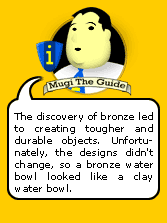|



|
 Bronze is well-represented in the Museum and the collection, which comprises up to 3,199 pieces, is absolutely spectacular. Bronze is well-represented in the Museum and the collection, which comprises up to 3,199 pieces, is absolutely spectacular.
The Bronze Age in Indonesia is estimated as having begun around the 1st century BC, and it drastically changed man's way of life both practically and culturally. Bronze is a mixture of copper and tin, and as it has a low melting point, objects were either produced by forging (heating then beating the bronze) or by wax-casting techniques. Bronze axes, ceremonial items and jewellery were the most popular items made.
With the onset of the Classical Age production and casting processes improved, and techniques such as soldering were introduced. Bronze items became more varied, ranging from statues of Buddha for worship to domestic appliances, and their decoration more ornate. Bronze was also used to replace materials that were easily damaged, so the shape of domestic appliances, for example, did not radically change - a water jar would look the same in bronze as it did in terracotta.
?
|